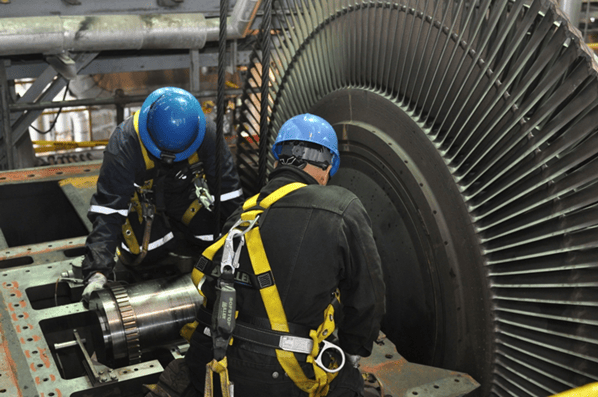Public Programs
STEAM & GAS TURBINES: CURRENT AND COMMON ENGINEERING PROBLEMS & THEIR SOLUTIONS FOR INDUSTRY
Course Introduction
A steam turbine is a device that extracts thermal energy from pressurized steam and uses it to do mechanical work on a rotating output shaft.
Because the turbine generates rotary motion, it is particularly suited to be used to drive an electrical generator – about 90% of all electricity generation is by use of steam turbines. The steam turbine is a form of heat engine that derives much of its improvement in thermodynamic efficiency from the use of multiple stages in the expansion of the steam, which results in a closer approach to the ideal reversible expansion process.
The Gas Turbine Engineering function in any organisation encompasses many disciplines touching upon different aspects of Gas Turbine plant operation and facility management. The advent of new Gas Turbine designs and applications has transformed this function into one that is becoming highly specialized and increasingly sophisticated. In recent times, there is a huge demand for highly skilled, knowledgeable and practically oriented turbine engineers.
This course provides a comprehensive overview in the area of turbine engineering and is designed to develop your overall skills, boost your career options, and benefit your employer/employee. The numerous practical application tips and short cuts to engineering problem solving imparted during the course make it highly practical and relevant to your applications and its successful completion will provide a gateway to a fulfilling, intensive, yet enjoyable career.
Ease of installation, serviceability and operational and design flexibility are critical factors determining the success of any turbine installation. In order to identify and select a suitable system for a particular application, it is important that the selection and design related parameters are properly understood. For example, fuel economy is critical in the success of any turbine operation.
This course places the tried and tested and latest practices and technologies in perspective, while also equipping the participants with the requisite knowledge and skill sets needed to tackle problems related to various systems in a facility.
Course objective
Upon completion of this course, participants will have gained a thorough understanding of the various turbine configurations available to virtually every industrial user. Items discussed include mechanical design features, sizing and application criteria, maintainability, reliability, vulnerability, and troubleshooting issues.
Participants will learn simple techniques and short-cut methods of machinery selection, which can take the place of tedious hand calculations and will serve as means to determine sensitivity or influence of parameter changes on equipment performance.
Participants will be able to determine the most appropriate and efficient matching of compressor or pump to a turbine.
Participants will also acquire knowledge of operating and maintenance issues by getting to know mechanical design, machinery components, piping design, as well as proven approaches to monitoring, troubleshooting, and maintenance of compressor installations.
WHO SHOULD ATTEND
Senior technicians, operators, supervisors, superintendents and corporate engineering, plant planning and design, systems design, equipment selection and evaluation, and equipment maintenance personnel. Also, equipment and systems specialists in engineering contractor firms and managerial and supervisory individuals responsible for operations and maintenance functions.
Course Content
Day 1
Steam Turbines
- Operating Principles,
- Impulse Turbines,
- Reaction Turbines,
- Application Ranges,
- Configurations,
- Application Constraints
Turbine Components
- Turbine Rotors,
- Blading,
- Diaphragms,
- Nozzles,
- Steam Chests,
- Glands and Gland Systems,
- Bearings,
- Balancing,
- Rotor Dynamics,
- Governing Systems,
- Lube Oil Management
Overview of Selection and Sizing of Steam Turbines for Reliability
- Thermodynamics,
- Steam (Water) Rates,
- Condensing and Backpressure Turbines,
- Single and Multistage Types,
- Process Considerations
Operation and Maintenance of Steam Turbines
- Commissioning,
- Start-Up,
- Run-In and Shut-Down,
- Surveillance and Health Monitoring,
- Performance Measurement,
- Monitoring and Tracking,
- Steam Turbine Washing,
- Steam Turbine Inspection,
- Maintenance, Overhaul and Repair
Day 2
General Overview of Gas Turbines
- Introduction
- Frame type heavy-duty gas turbines
- Industrial type gas turbines
- Small and micro gas turbines
- Gas turbine components
Fundamental Gas Turbine Cycle Thermodynamic
- Reversible cycles with ideal gases
- Constant pressure or Brayton cycle
- Ideal inter-cooled and reheat cycles
- Actual gas turbine cycles
- List of terms and symbols used
Gas Turbine Components
- Compressors
- Centrifugal compressors
- Axial-flow compressors
- Compressor theory
- Compressor aerodynamics
- Common problems affecting axial compressor operation and performance
- Air compressor performance characteristics
- Combustors
- Combustor performance and efficiency
- Turbines
- Fuel nozzles and igniters
- Emission control
Materials of Construction
- Introduction
- General metallurgical behavior in gas turbines
- Gas turbine blade materials
- Blade manufacturing techniques
- Future materials
Bearings and Seals
- Bearing materials
- Through hardened materials
- Case hardened materials
- Cage materials
- Babbitts
- Bearing design principles
- Tilting-pad journal bearings
- Design of thrust bearings
- Seals
Question &Answer Session
End of Workshop

- 3 & 4 DEC 2025
- WED & THU
- 9AM - 5PM
- WYNDHAM GRAND BANGSAR KUALA LUMPUR HOTEL
By: FACE-TO-FACE PUBLIC PROGRAM
Download Program Brochure:
Follow Us:
Program Highlights & Key Details
How To Submit an Enquiry to Us?
- Fill in the form below and submit to us.
- Initiate a conversation via live chat on the bottom left of our website by stating: “Hi, my name is [your-name]. I’ve already submitted the form for this training.”
- We’ll promptly reach out to you regarding the training you’re interested in.
THANKYOU FOR YOUR ENQUIRY
Lorem ipsum dolor sit amet, consectetur adipiscing elit. Ut elit tellus, luctus nec ullamcorper mattis, pulvinar dapibus leo.
